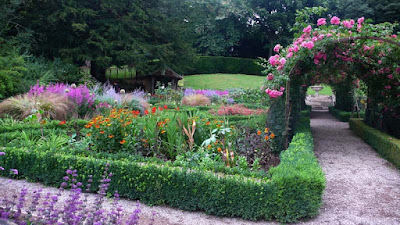This week friends who volunteer at Tyntesfield, a National Trust property near Bristol, took us around the estate. It had belonged to the same family for four generations, a span of two hundred years. Luckily for the Trust, when they started the restoration they discovered that the family had never thrown anything away!

Formal gardens front the house
and below them is the arboretum
with many handsome old trees.
The 'rose garden'
is no longer planted with roses
because they proved too irresistible to the local deer.
The rose garden in the Victorian era.
Now there is neat box hedging and mixed planting that apparently doesn't taste as good as roses!
Two summerhouses echo the symmetry of the stone lions that stand either side of the rose garden entrance.
They were in a poor condition but have now been beautifully restored.
Piles of discarded tiles were found and it was possible to fill in the many gaps.
The estate is set on a south-facing slope
with lovely views down the valley.
This stone path across the meadow leads to the kitchen garden. When the Trust took over the estate in 2002 the path was hidden under grass. One of the staff took a spade to a piece of the meadow, found stones and unrolled the covering as though it were a strip of carpet. What a lovely find!
A central 'G' for Gibbs, the family name, and a Latin inscription which translates as, 'Tenacious of Purpose'.
The walled kitchen garden was a joy to behold. I believe that it's the only one to have been in continuous cultivation since it's construction.
No reason for it not to look immaculate in the past when labour was cheap. Flat caps and attitude!
This is such a good idea that I'm going to steal it for my veg plot next year and plant far more flowers among the crops. I've only ever used marigolds so far as a means of fooling carrot fly.
A long, thin glasshouse on the south wall
and a peep inside shows me rows of peach and nectarine.
There are more glasshouses outside the walled garden.
And lovely colour schemes.
This curved door intrigued me greatly. It accesses a passageway that was used solely by the servants so that they could come and go without disturbing the household.
The door would have opened into a magnificent conservatory which sadly no longer exists.
What a life the family led!
Our friends informed me that this stone animal is called a 'Hunky Punk', a word I'd never heard before. It isn't a gargoyle, which serves the purpose of spouting water from the roof. The sole purpose of the Hunky Punk is to be decorative.
The decorative elements of the house, Victorian Gothic in style, were added to the earlier structure.
There's so much to see inside.
But that's for another time.









































How lovely the estate is now, proudly showing itself for the future generations.
ReplyDeleteI last looked around when the estate had just been acquired by the National Trust and it is quite a transformation, but still very much work in progress.
DeleteThose grounds are so well kept! Very pretty tour. :)
ReplyDeleteYes, I was impressed by how well it was being run. Apparently they have an army of volunteers!
DeleteLovely place a happy place to spend a few hours.
ReplyDeleteMerle..........
We were there from two until five and only saw part of the grounds and had a quick dash through the house. We shall have to visit again.
DeleteThank you for taking us on a tour. Wouldn't it be wonderful to have a walled garden? I'm imagining what life would have been like living at that estate - incredible. -Jenn
ReplyDeleteYes, there's something really special about a walled garden. No howling wind for starters!
DeleteIt must have been wonderful having a personal tour. I have often seen the house and garden featured in blog posts, it looks wonderful and must be fantastic to volunteer there. Sarah x
ReplyDeleteReally a beautiful blog.It is very astonishing and marvelous design.
ReplyDeleteดูหนังออนไลน์